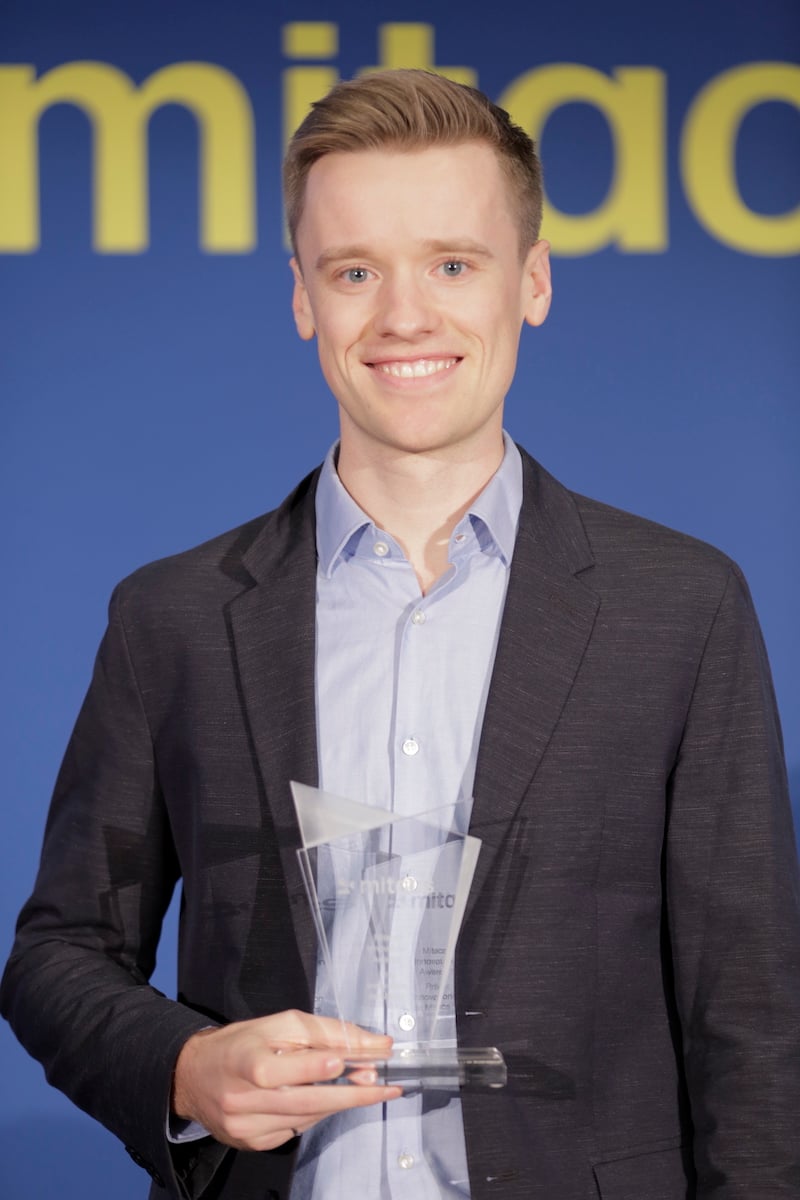David Black uses his mixed reality headset as if he were providing a patient with an ultrasound in a remote setting. The holographic image shows where he is being told to move the ultrasound probe. Photo submitted.
Michelle Gamage November 25 2024 The Tyee
Michelle Gamage is The Tyee’s health reporter. This reporting beat is made possible by the Local Journalism Initiative.
Bringing diagnostic tools to remote areas will reduce the time and money patients spend to access health care, says David Black.
A University of British Columbia PhD student has invented a new way to connect patients in rural and remote communities with ultrasounds without patients having to leave their communities.
For this invention, David Black was given the Mitacs Innovation Award for Outstanding Innovation at the National Arts Centre in Ottawa on Tuesday. Mitacs is a non-profit national research organization that partners with Canadian post-secondary students, private industry and government to fund research and foster innovation.
The award recognizes extraordinary talent from across Canada whose Mitacs-funded research has the potential to achieve larger societal and economic impacts, according to the organization. Mitacs is itself funded by the federal and provincial governments.
Remote ultrasounds will allow health-care professionals to better triage patient care and help people living in remote communities avoid unnecessary travel, says Black, a PhD student in the department of electrical and computer engineering under the supervision of UBC professor Tim Salcudean.
Currently, people in remote communities pay extortionate amounts to access ultrasounds, which tend to take only a few minutes, Black says.

As an example Black points to Bella Bella, a remote community on British Columbia’s central coast. He says community members collectively spend around $500,000 per year to fly to Vancouver for ultrasound appointments.
Research done by UBC Centre for Rural Health Research co-founder Jude Kornelsen in 2020 found that rural residents pay an average of $2,234 in out-of-pocket expenses per diagnosis, per individual, accounting for travel, meal, accommodation and lost wage costs.
If an ultrasound could be done in a resident’s community, that would save people time and money and reduce carbon emissions, Black says. There’s also the added benefit of being able to access health care no matter the weather and giving the patient the ability to ask for a family member or trusted community member to perform the exam, he says.
Black says his invention was tested this summer in Skidegate, on Haida Gwaii, where 10 healthy volunteers had abdominal ultrasounds done at the Skidegate Health Centre. The ultrasounds were led by two expert sonographers 750 kilometres away at UBC’s Vancouver campus and performed by volunteers in Skidegate.
Normally people living in Skidegate have to take an eight-hour ferry to Prince George for an ultrasound, which requires a full day of travel each way and a day to be in Prince George, which means taking several days off work or arranging child care to access a single test, Black says. Depending on the season, weather can disrupt ferry sailings and extend travel time.
Using Black’s system, sonographers see the ultrasound reading and a video of the patient in real time, connected over Wi-Fi or 5G, and manoeuvre the ultrasound probe using a type of lever that mimics the shape and manoeuvrability of the probe.
In Skidegate, a volunteer wore a mixed reality headset and could see both the patient and a hologram image of where and how the expert had placed the ultrasound probe. The ultrasound probe has pressure sensors on it, allowing the volunteer to mimic the placement, angle and pressure that the expert wants.
When the expert sees the ultrasound reading in real time, they are able to, for example, use their lever to push a little harder and lean the probe slightly to the right. The volunteer would see the hologram shift slightly to the right and that the colour of the hologram has shifted too. Blue means too little force, green means the right amount and red means too much.
The volunteers “resoundingly” said that the system was easy to use and needed minimal time to learn, Black says.
Black says the goal is to make tele-ultrasound “more accessible than video calling,” in a way that helps, but does not replace, doctors.
Remote scans could help identify both patients who don’t need further medical care, saving them an unnecessary trip, and patients who do need further medical care, he said.
“Ultrasound is becoming a main diagnostic tool in trauma calls,” Black said. One day his device could be used by paramedics or search and rescue teams to check patients for internal bleeding while still in the backwoods, he said.
Rural barriers to health care
Many British Columbians who live in urban settings have a hard time understanding some of the challenges people have accessing health care in more rural and remote settings, says Paul Adams, executive director of the BC Rural Health Network.
These challenges started more than 20 years ago when B.C. split the province up into regional health authorities, which centralized health-care services in larger urban centres, Adams says. The last couple of decades have seen public and cross-provincial transportation diminish, adding to access challenges, he adds.
“The development of the ultrasound piece from a remote diagnostic perspective is fantastic and we support those types of initiatives,” Adams said.
The Rural Coordination Centre of BC is running a similar program called Real-Time Virtual Support, which is working to bring virtual care to Indigenous communities in the north and providing specialty consultations online, Adams says.






